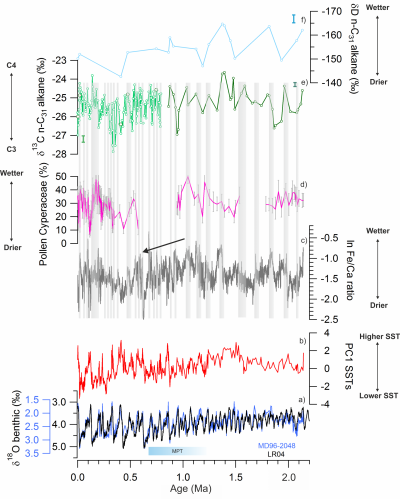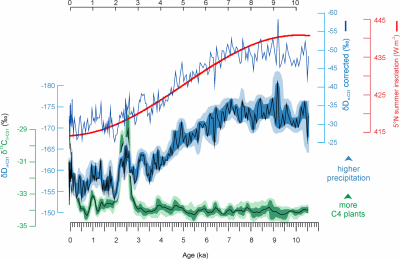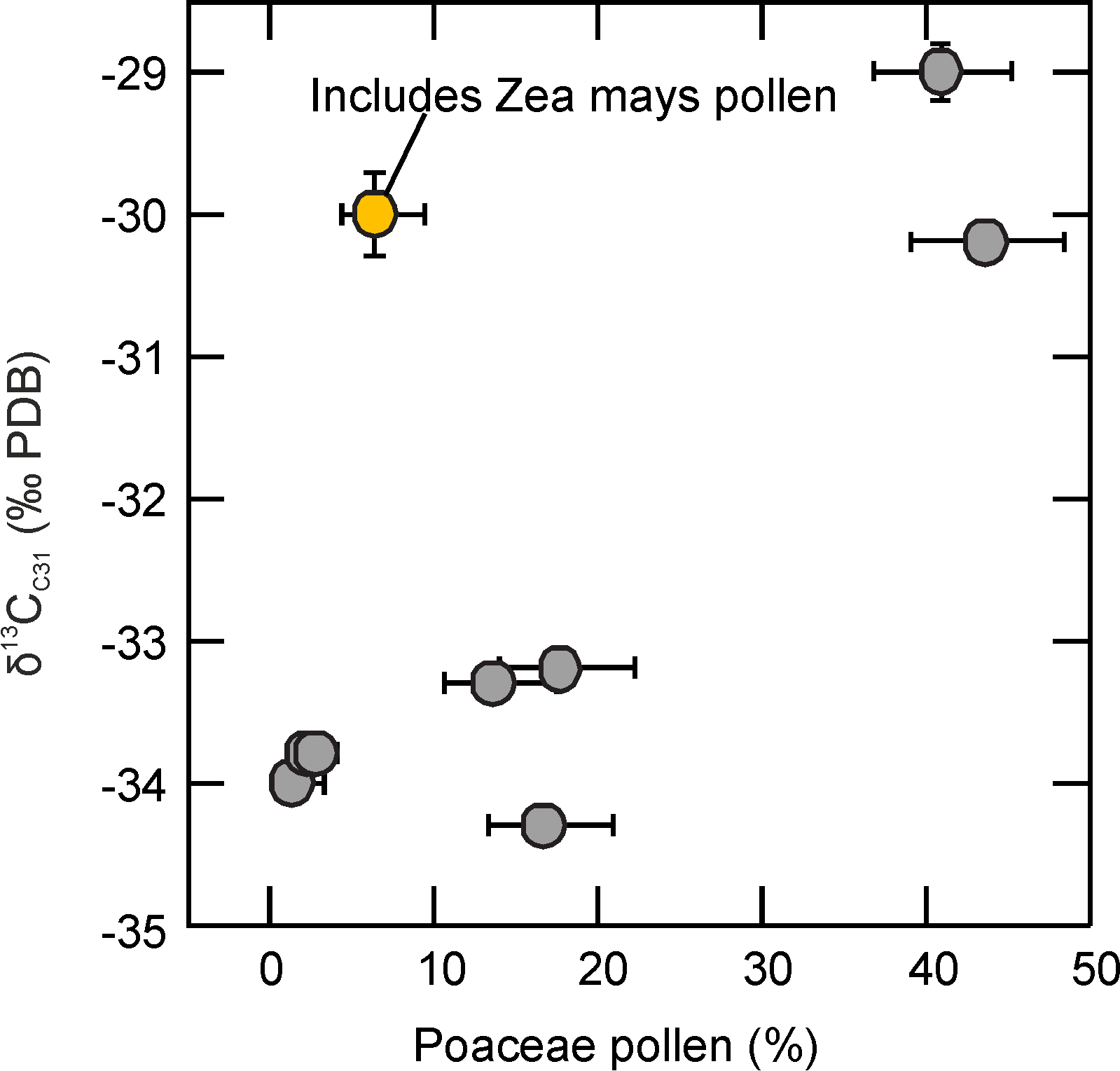- Home
- Climate and archaeology
Climate and archaeology
Human evolution and climate change
Vegetation and climate development of South Africa are interesting in particular because the archaeology of the region substantially contributed to the understanding of human origins.
Continuous vegetation record of the Greater Cape Floristic Region (South Africa) covering the past 300 thousand years (IODP U1479)
Dupont LM, Zhao X, Charles C, Faith JT, Braun, D
Climate of the Past Discussions (in review)
https://doi.org/10.5194/cp-2021-93
A two million year hydroclimatic context for hominin evolution in southeastern Africa
Caley T, Extier T, Collins JA, Schefuß E, Dupont L, Malaizé B, Rossignol L, Souron A, McClymont EL, Jimenez-Espejo FJ, Garcia-Comas C, Eynaud F, Martinez P, Jorry SJ, Charlier K, Wary M, Gourves P-Y, Billy I, Giraudeau J
Nature 560 (2018) 76-79
https:doi:10.1038/s41586-018-0309-6
We combined very different kinds of analyses and investigated hydrogen and carbon isotopes of molecular plant waxes and compared them with the results of pollen analyses and element compositions. (Figure 2 from Caley et al. 2018)

Hydrological changes in the Limpopo catchment compared to sea surface temperatures of the southwestern Indian Ocean over the last 2.14 Ma.
Bottom up. a) δ18O of benthic foraminifera compared to the reference LR04 curve (Lisiecki & Raymo, 2004) providing the stratigraphy and age model. MPT denotes the Mid Pleistocene Transition. b) Sea surface temperatures estimated after foram assemblages and Mg/Ca measurements. c) ln(Fe/Ca) XRF ratios indicating the terrestrial contribution to the marine sediments. Arrow indicates the long-term trend toward less Limpopo River discharge. Grey frames represent events of hydrological cycle intensification. d) Pollen percentages of Cyperaceae. e) δ13C of the n-C31 alkane of plant waxes (from Castaneda et al., 2016 in light green and this study in dark green) indicating the relative abundance of C4 plants in the vegetation. Note the correspondence with the Cyperaceae pollen percentages suggesting that a substantial part of the C4 signal comes from large tropical sedges (for instance papyrus) in the Limpopo catchment area during wet phases. f) δD of the n-C31 alkane of plant waxes, in this region indicative of the amount of rainfall.
NB: time scale runs from right (old) to left (young)
Human influence vs climate
The roles of climate and human land-use in the late Holocene rainforest crisis of Central Africa
Bayon G, Schefuß E, Dupont L, Borges AV, Deenielou B, Lambert T, Mollenhauer G, Monin L, Ponzevera E, Skonieczny C, André L
Earth and Planetary Science Letters 505 (2019) 30–41
doi:10.1016/j.epsl.2018.10.016
Early anthropogenic impact on Western Central African rainforests 2600y ago
Garcin Y, Deschamps P, Ménot G, De Saulieu G, Schefuß E, Sebag D, Duont LM, Oslisly R, Brademann B, Mbusnum KG, Onana J-M, Ako AA, Epp LS, Tjallingii RT, Strecker MR, Brauer AB, Sachse D
PNAS 115 (2018) 3261-3266
doi:10.1073/pnas.1715336115
The Central African rain forest has long been regarded as primeval and largely without human impact, climate being considered as the sole cause of the disappearance of the rain forest around Lake Barombi in Cameroon ca. 2600 years ago and its reappearrance roughly 600 years later. The study published in the Proceedings of the National Academy of Sciences (PNAS) shows that climate cannot have been the reason.
Carbon and hydrogen isotopes of higher plant waxes stored in the lake sediments provide a record of C4 vs C3 vegetation (in this case roughly savannah vs forest) and an estimate of rainfall, respectively, both measured on n-alkanes. Pollen analysis confirms that grasses are the main source of C4 plant material.

Records of environmental change from Lake Barombi over the past 10,500 y and comparison with local summer insolation.
In red the long-term insolation changes at 5°N for June–July–August. In green stable carbon isotopes of n-alkane C31 and in blue hydrogen isotopes measured on the same n-alkane. More negative Deuterium values indicate wetter conditions, while less negative carbon isotopes indicate more C4 vegetation. The upper blue curve shows the Deuterium values corrected for C4 material indicating no sudden drop in rainfall between 2600 and 2000 BP.
NB: time scale runs from right (old) to left (young)

High grass pollen percentages correspond with increased C4-plant wax with the exception of the topmost sample that contained a pollen grain of Zea mays. Maize is a C4 plant but produces few large pollen grains.


